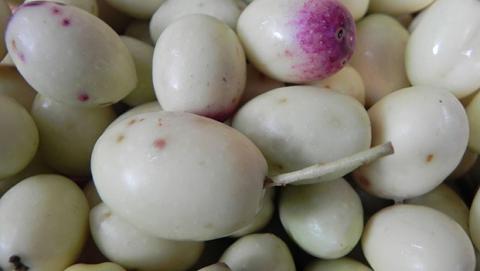
White Olives of Nova Siti
This post is also available in:
 Italiano (Italian)
Italiano (Italian)
Two plants of Olea europaea ‘Leucocarpa’ or ‘Leucolea’ have been found by two young “custodi della biodiversità” Antonio Manolio and Carlo Stigliano, in the city quarters of Nova Siri (MT) Pizzarello and Pietrosa, in Basilicata. These plants are an antique variety of a rare white olive, which is possible to find nowadays only in few plantations concentrated in Calabria. It was introduced in Italy by the Greeks in the VIII century a.C., and its peculiarity consists in producing fruits without pigment, which assume an ivory like colour, since they cannot make the anthocyanin synthesis. In addition, the fruits can remain on the plant for longer periods than other olive varieties, also till spring.
The olive trees, which started spreading between the VII and X century A.D. in Basilicata, have been found around small farms belonging to monasteries in the past and have been saved and reproduced through grafts. Historical sources tell that Basilian monks living there used to cultivate this plant, because the light oil, also called “olio del krisma”, was used in religious services to anoint priests, as sacred oil for sacraments like Christenings, Confirmations or Anointings of the sick, and to anoint the Byzantine imperial vassals. In addition, it was used to light lamps in places of worship, since it produced few smoke, when burnt.
On the stone terracing present in the two city quarters of Nova Siri, a real biodiversity park grows: apart from the two “Leucarpa” olive trees, it is possible to find centuries old olive trees, different varieties of almond trees, grapes, pomegranates, pears, figs, quinces, loquats and officinal plants (among them there is a nearly 6 meters tall laurel). The two young manufacturers renamed the olive with the symbolic name “Bianca di Magna Grecia”, the fruit may become the symbol of the important biodiversity patrimony of Parco Archeologico della Magna Grecia; a park which is going to develop around this area.
Now “Agia”, which means “Associazione Giovani Imprenditori Agricoli”, together with the two young guardians, wants to start to control how many plants of “Leucocarpa” are present in Basilicata, compare morphologically the fruits and the leaves of these plants with the ones present in Calabria. In addition, they want to signal this fruit to Slow Food.
This post is also available in:
 Italiano (Italian)
Italiano (Italian)
Contatti
Contrade Pizzarello e Pietrosa, a Nova Siri (MT)(MT)

